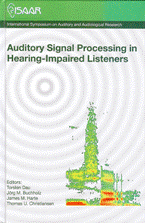The “Auditory Profile”: Proposal from the European HEARCOM project
Abstract
This paper describes a new approach to auditory diagnostics, which is one of the central themes of the EU-project HEARCOM. For this purpose we de ned a so-called “Auditory Profile” that can be assessed for each individual listener using a standardized battery of audiological tests that – in addition to the pure-tone audiogram– focus on loudness perception, frequency resolution, temporal acuity, speech perception, binaural functioning, listening effort, subjective hearing abilities, and cognition. For the sake of testing time only summary tests are included from each of these areas, but the broad approach of characterizing auditory communication problems by means of standardized test is expected to have an added value above traditional testing in understanding the reasons for poor speech reception. The auditory profile may also be relevant in the field of auditory rehabilitation and for design of acoustical environments.
References
Hagerman, B. (1982). ”Sentences for testing speech intelligibility in noise,” Scand. Audiol. 11, 79-87.
Larsby, B., and Arlinger, S. (1998). “A method for evaluating temporal, spectral and combined temporal-spectral resolution of hearing,” Scand. Audiol. 27, 3-12.
Larsby, B., Hällgren, M., Lyxell, B., and Arlinger, S. (2005). ”Cognitive performance and perceived effort in speech processing tasks: effects of different noise backgrounds in normals and in hearing-impaired subjects,” International Journal of Audiology, 44, 131-143.
Plomp, R., and Mimpen, A. M. (1979a). “Improving the reliability of testing the speech reception threshold for sentences,” Audiology 18, 43-52.
Ringdahl, A., Eriksson-Mangold, M., and Andersson, G. (1998). “Psychometric evaluation of the Gothenburg Profile for measurement of experienced hearing disability and handicap: applications with new hearing aid candidates and experienced hearing aid users,” Br. J. Audiol. 32, 375-385.
Wagener, K., Brand, T., and Kollmeier, B. (1999a). ”Development and evaluation of a German sentence test part I: Design of the Oldenburg sentence test,” Z. Audiol. 38, 4-15.
Wagener, K., Brand, T., and Kollmeier, B. (1999b). “Development and evaluation of a German sentence test part II: Optimization of the Oldenburg sentence test,” Z. Audiol. 38:44-56.
Wagener, K., Brand, T., and Kollmeier, B. (2007). “International cross-validation of sentence intelligibility tests,” Proceedings EFAS conference Heidelberg, 2007.
Additional Files
Published
How to Cite
Issue
Section
License
Authors who publish with this journal agree to the following terms:
a. Authors retain copyright* and grant the journal right of first publication with the work simultaneously licensed under a Creative Commons Attribution License that allows others to share the work with an acknowledgement of the work's authorship and initial publication in this journal.
b. Authors are able to enter into separate, additional contractual arrangements for the non-exclusive distribution of the journal's published version of the work (e.g., post it to an institutional repository or publish it in a book), with an acknowledgement of its initial publication in this journal.
c. Authors are permitted and encouraged to post their work online (e.g., in institutional repositories or on their website) prior to and during the submission process, as it can lead to productive exchanges, as well as earlier and greater citation of published work (See The Effect of Open Access).
*From the 2017 issue onward. The Danavox Jubilee Foundation owns the copyright of all articles published in the 1969-2015 issues. However, authors are still allowed to share the work with an acknowledgement of the work's authorship and initial publication in this journal.


